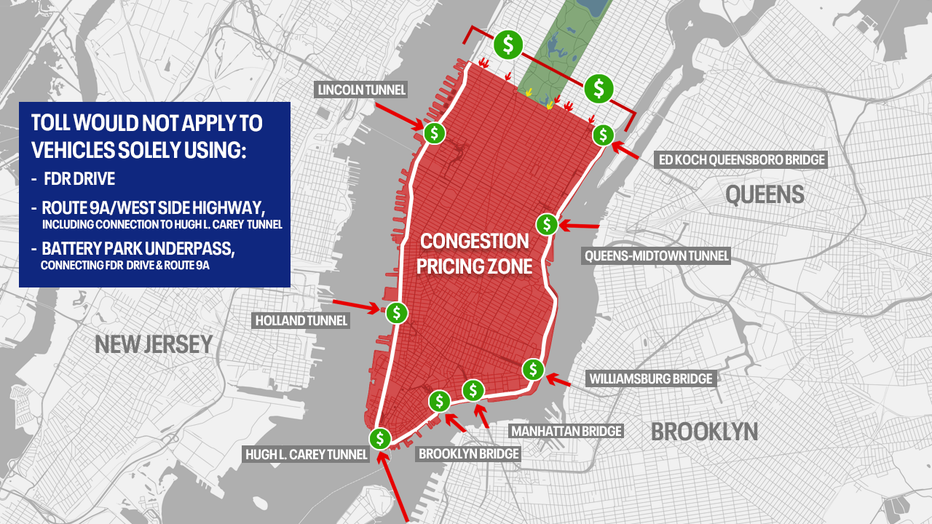NYC congestion pricing in effect: Drivers' guide for map, costs and exemptions

Congestion pricing launches in NYC
The first weekday of New York City's congestion pricing policy saw lighter-than-expected traffic, but questions remain whether the $9 peak-hour toll is responsible. The MTA estimates the fee could keep 100,000 vehicles out of the city daily, reduce emergency response times, and raise $15 billion to improve subways and buses. FOX 5's Linda Schmidt has the story.
NEW YORK CITY - New York City has officially become the first U.S. metro to implement a congestion pricing toll, and now, most drivers entering Manhattan's congestion zone will face a $9 toll.
CONGESTION PRICING NYC: MAP l COST l DISCOUNTS
The landmark initiative, which began on Sunday, is designed to reduce traffic congestion, improve air quality and raise funds for much-needed public transit upgrades, although critics have said it is just one more unfair cost to commuters to fund the MTA.

Uber riders wrongly hit with congestion fees
FOX 5 NY got some answers after our own Natasha Verma was hit with a congestion pricing fee while taking an Uber, even though she didn?t enter the congestion pricing zone. Now Uber says they will be issuing refunds to not only Natasha, but to any other rider who might have faced the same issue. FOX 5 NY?s Linda Schmidt reports.
SEE ALSO: Uber hits some riders with mistake congestion pricing fee | Exclusive
After years of studies, delays and a last-ditch bid by New Jersey to halt the toll, the program launched without major hiccups early Sunday. But transit officials cautioned the first-in-the-nation scheme could require adjustments — and likely would not get its first true test until the workweek.
"This is a toll system that has never been tried before in terms of complexity," Metropolitan Transportation Authority Chair and CEO Janno Lieber said at a press conference held at Grand Central Terminal Sunday. "We don’t expect New Yorkers to overnight change their behavior. Everybody’s going to have to adjust to this."
Track breaking congestion pricing news and local headlines on the FOX LOCAL app. Click here to download on iPhone and here to download on Android.
What is congestion pricing?
Congestion pricing is an electronic tolling system that charges vehicles for entering Manhattan's Congestion Relief Zone (CRZ) — the area below 60th Street, excluding certain highways like the FDR Drive and West Side Highway. The program aims to:

New Jersey commuter toll increases
Some New Jersey drivers, already getting hit with the new NYC congestion pricing toll, are also facing an increase at Port Authority tunnels and bridges. FOX 5 NY's Briella Tomassetti has the details.
- Reduce gridlock in Manhattan's busiest areas.
- Encourage public transit use.
- Fund approximately $15 billion in transit infrastructure improvements.
Congestion pricing map
Vehicles entering the Manhattan zone, which are local streets and avenues at or below 60 Street – near Central Park – will be charged a toll.

This map shows the zone for New York City congestion pricing.
Who will be charged?
Drivers entering the CRZ will pay a toll, but there are exceptions and discounts for certain roads.
- Exempt roads: No tolls will be charged for vehicles using the FDR Drive, West Side Highway, or roads connecting the Hugh L. Carey Tunnel.
- Local traffic: Cars that stay within the CRZ or use exempt roads without crossing the boundary are not charged.
How does it work?
Most tolls will be collected through E-ZPass, thanks to gantries already set up at the congestion zone entry points.
Drivers without an E-ZPass will be mailed a bill and forced to pay a higher rate.
How much will it cost?
Fees vary depending on vehicle type and time of day:
Featured
NYC congestion pricing could cost NJ commuters as much as $22 a day
Drivers heading into Manhattan below 60th Street will pay an estimated $9 toll per trip, and those traveling through Port Authority crossings will pay an additional $16 toll. Even with a crossing credit, the daily cost will hover around $22.
Peak hours (5 a.m. – 9 p.m. weekdays l 9 a.m. – 9 p.m. weekends)
- Passenger vehicles: $9 with E-ZPass ($13.50 by mail).
- Motorcycles: $4.50 with E-ZPass ($6.75 by mail).
- Small trucks: $14.40.
- Large trucks and buses: $21.60.
Off-peak hours (9 p.m. – 5 a.m. weekdays l 9 p.m. – 9 a.m. weekends)
Toll rates drop by 75%:
- Passenger vehicles: $2.25.
- Motorcycles: $1.05.
Are there discounts or exemptions?
Yes. Here are key benefits for specific groups:
Featured
2025 commuter price hikes: What subway, tolls, buses, Citi Bike will cost
With subway fares inching closer to $3, higher Citi Bike fees, and substantial tolls for drivers, 2025 is shaping up to be a costly year for commuters.
- Low-income drivers: Those earning under $50,000 annually qualify for a 50% discount after their 10th monthly trip.
- Emergency vehicles and disabled drivers: Fully exempt.
- Tunnel credits: Drivers using the Holland, Lincoln, Hugh L. Carey, or Queens-Midtown tunnels will receive crossing credits ranging from $1.50 to $3.
Impact on taxis and rideshares
Taxis, green cabs and black cars face a 75-cent surcharge per trip, while app-based services like Uber and Lyft charge $1.50 per trip for rides that begin, end, or pass through the CRZ.
What will the money be used for?
Revenue from congestion pricing will support critical upgrades to the city’s transit systems, including:
- Modernizing subway infrastructure.
- Adding buses and increasing service frequency on 23 routes, including Staten Island express buses and popular Brooklyn lines.
How to prepare
- Get E-ZPass: Save up to 50% on tolls compared to mail-based billing.
- Plan your route: Use toll-exempt highways like the FDR Drive or West Side Highway to avoid charges.
- Explore transit alternatives: Take advantage of expanded bus and subway services.



